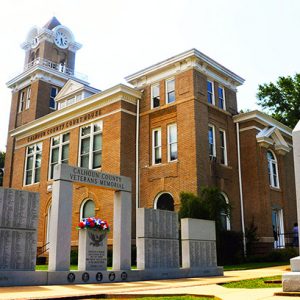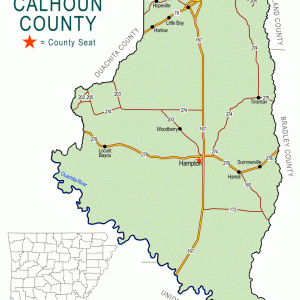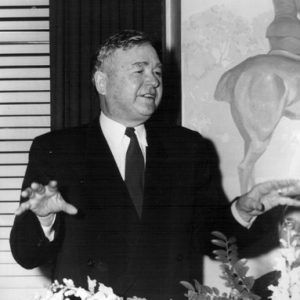calsfoundation@cals.org
Hampton (Calhoun County)
County Seat
| Latitude and Longitude: | 33º32’16″N 092º28’11″W |
| Elevation: | 202 feet |
| Area: | 3.28 square miles (2020 Census) |
| Population: | 1,181 (2020 Census) |
| Incorporation Date: | January 27, 1853 |
Historical Population as per the U.S. Census:
|
1810 |
1820 |
1830 |
1840 |
1850 |
1860 |
1870 |
1880 |
1890 |
1900 |
|
– |
– |
– |
– |
– |
– |
138 |
150 |
132 |
– |
|
1910 |
1920 |
1930 |
1940 |
1950 |
1960 |
1970 |
1980 |
1990 |
2000 |
|
353 |
271 |
669 |
686 |
838 |
1,011 |
1,252 |
1,627 |
1,562 |
1,579 |
|
2010 |
2020 |
|
|
|
|
|
|
|
|
|
1,324 |
1,181 |
|
|
|
|
|
|
|
Hampton has served as the seat of Calhoun County since the county was created in 1850, and it remains the county’s most populous city.
Louisiana Purchase through Early Statehood
The first white person to patent a claim in the area of what is now Hampton was Nathaniel Hunt of Tennessee, who arrived in 1848. He established a farm on the north side of what was later the Hampton and Warren Road. When Calhoun County was created in 1850, a county seat was established near Hunt’s farm due to its central location and named Hampton for Colonel John R. Hampton, a state senator.
Oliver Hazard Perry Black of Union County settled in Hampton around 1850, starting the first store there. In 1851, he was appointed postmaster. Other early merchants included Alex Manor, John Davis, Louis Ella, and J. M. Farrior. The first county court met on May 27, 1851, and the first county courthouse was completed in October 1851. On January 27, 1853, the settlement incorporated for the first time. John C. Barrow established Hopeville Academy in Calhoun County in 1859.
Civil War through Reconstruction
By 1860, slaves made up nearly one-fourth of Calhoun County’s population; cotton was an important crop in the area. In May 1861, local lawyer Joe McCullough raised a company of Confederate soldiers that later joined the Fourth Arkansas Infantry. Black sold his business and, with the money, raised a Confederate company known as the Calhoun Invincibles. On October 15, 1861, this company left Hampton for Fort Smith (Sebastian County), where it joined the Fourth Arkansas Regiment. Barrow was among those who served with this unit. Companies continued to be raised in Hampton throughout the war years.
There were no military operations in Calhoun County during the Civil War. However, in 1864, local soldiers burning cotton accidentally set fire to Black’s storehouse. The fire spread to three other stores.
After the war, Barrow maintained farmland in and around Hampton, employing tenant farmers to raise cotton. The city of Hampton reincorporated in 1871. The city was the site of some acts of Reconstruction-era violence. One notable event occurred in 1872, when a mob stormed the jail and set it afire, killing an African American prisoner.
Post Reconstruction through the Gilded Age
In 1883, the St. Louis, Arkansas and Texas Railway (commonly known as the Cotton Belt) ran a line through northern Calhoun County. Hampton subsequently lost commercial importance as new towns grew up alongside this rail line. The coming of the railroad resulted in the rise of the timber industry in Calhoun County. Lawyer Charles Locke Poole of Hampton, who represented the county in the state legislature from 1899 to 1903, built a fortune acquiring large blocks of timber land for the mills.
In 1888, W. T. Brickell of Thornton (Calhoun County) sold the Thornton Record newspaper, and it was subsequently removed to Hampton, becoming the Calhoun County Courier. In November 1888, the offices of the newspaper were destroyed in a fire, but the operation continued.
Following the passage of the Election Law of 1891, many African Americans were deprived of their right to vote, primarily on the basis of literacy examinations. However, on September 5, 1892, a group of African Americans in Hampton went to the polls armed, determined to vote. Election officials responded with violence, resulting in what newspapers called a “race war.” Four African Americans were killed, and many others were arrested for disturbing the peace. That was not the only case of racial violence in the city, however. On July 14, 1895, brothers Jim and Jack Ware were lynched in Hampton for allegedly assisting with a murder.
Early Twentieth Century
The present Calhoun County Courthouse, designed by Little Rock (Pulaski County) architect Frank W. Gibb, was built in 1909 and features a clock tower and Classical and Colonial Revival details. The courthouse was listed on the National Register of Historic Places in 1976. The same year the courthouse was built, Poole built a home that was a local landmark for several decades. It was damaged in a 1968 hail storm, however, and torn down to make way for a supermarket.
Many new commercial buildings were constructed in Hampton in the early twentieth century. Among the noteworthy buildings was the two-story Hampton Masonic Lodge, built in the 1920s. It later housed the Farmers Home Administration and several mercantile establishments before being acquired by the county for use as a public library.
Among the New Deal agencies active in Hampton during the Great Depression was the Public Works Administration, which awarded a $15,000 loan and a $12,191 grant to the city on July 21, 1936, for construction of a waterworks. This water tower was completed in March 1937 and continues to be used by the city into the twenty-first century. The water tower is listed on the National Register of Historic Places.
In the late 1930s, the city finally built its own power plant. Before that, a privately owned power plant had been providing electricity to some city residents for a few years.
World War II through the Modern Era
During World War II, many Hampton residents worked at the Schumaker Naval Ammunition Depot, which was situated on land in western Calhoun County and eastern Ouachita County.
The Hampton Municipal Airport began operations in April 1978. Situated south of Hampton, it has two runways and is owned by the city.
In the 1980s, many residents were excited at the possibility of lignite mining beginning in the county (lignite is a type of coal from which oil can be distilled), but the operations never came to fruition. However, the county does maintain a handful of oil fields. The possibility of mining lignite continues to be raised, especially as energy costs rise.
Hampton continues to depend upon local agriculture, which focuses largely upon cotton and tomatoes. The Hampton School District serves most of Calhoun County and has every grade through high school. The city is home to the South Arkansas Sun newspaper.
Famous Residents
Film and television producer Harry Z. Thomason was born in Hampton in 1940. He lived next door to Charles Pierce, who went on to write and direct numerous films that have become cult classics. Football star Carroll Wayne “Thumper” Harris was born in Hampton in 1938.
For additional information:
Biographical and Historical Memoirs of Southern Arkansas. Chicago: Goodspeed Publishing Co., 1890.
Newton, Willma Humphrey. “History of Vanished Landmark Recalled.” Arkansas Democrat Magazine. August 10, 1969, pp. 3–4.
Silva, Rachel. “Arkansas Listings in the National Register of Historic Places: National Register–Listed Properties of Hampton, Calhoun County.” Arkansas Historical Quarterly 69 (Winter 2010): 378–386.
Staff of the CALS Encyclopedia of Arkansas









Comments
No comments on this entry yet.